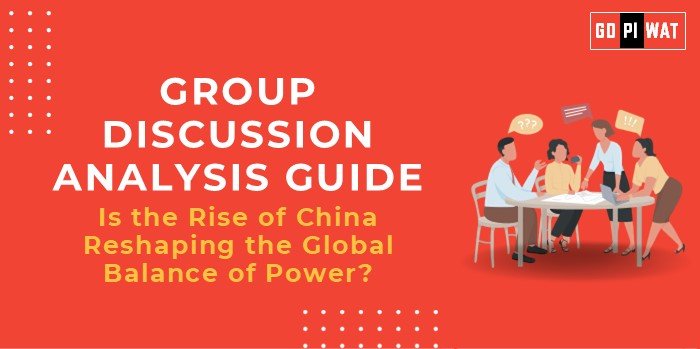📋 Group Discussion (GD) Analysis Guide
🌟 Is the Rise of China Reshaping the Global Balance of Power?
🌐 Introduction to the Topic
Opening Context: China’s rapid economic growth, technological advancements, and strategic global investments are transforming the international order. Once a regional power, China is now a pivotal player influencing global politics, economics, and security.
Topic Background: The rise of China began in earnest with economic reforms in 1978 under Deng Xiaoping, positioning the country as a manufacturing hub. Today, China’s Belt and Road Initiative (BRI), military modernization, and assertive foreign policy reflect its aspirations to challenge U.S.-led global dominance.
📊 Quick Facts and Key Statistics
- 🌍 Global Economy: China contributes over 18% of global GDP, second only to the U.S. (IMF, 2023).
- 💰 Military Spending: With an annual defense budget of $225 billion (2023), China ranks second globally.
- 🌐 Belt and Road Initiative: Over 140 countries have signed agreements with China under the BRI.
- 📡 Technology Leadership: Huawei leads 5G technology adoption, with a 29% global market share.
👥 Stakeholders and Their Roles
- 🇨🇳 China: Implements policies to expand economic, military, and technological influence.
- 🇺🇸 The U.S. and Allies: Actively counter China’s rise through strategic alliances like the Quad and AUKUS.
- 🌍 Developing Nations: Partner with China under BRI for infrastructure development, often incurring economic dependency.
- 🌐 Global Institutions: Adapt to shifting dynamics, reflecting China’s increased influence in bodies like the UN and WTO.
🏆 Achievements and Challenges
- 🎯 Achievements:
- Economic Powerhouse: China’s GDP grew from $1.2 trillion in 2000 to $19.3 trillion in 2023.
- Technological Advancements: Dominates AI research, patent filings, and green energy innovations.
- Military Expansion: The PLA Navy is now the world’s largest by fleet size.
- Soft Power Gains: Through Confucius Institutes and investments in Africa and Asia, China enhances its global image.
- ⚠️ Challenges:
- Geopolitical Tensions: U.S.-China trade wars and disputes over Taiwan, the South China Sea, and human rights.
- Economic Risks: Reliance on exports and challenges like an aging population and real estate crises.
- Global Criticism: Accusations of debt-trap diplomacy under the BRI.
🌍 Global Comparisons
- 🇺🇸 U.S.: Maintains technological and military supremacy but faces competition in economic and diplomatic arenas.
- 🇮🇳 India: Emerging as a counterbalance in Asia, focusing on economic reforms and defense partnerships.
Case Study: China in Africa: Through investments exceeding $148 billion (2000–2023), China has secured access to critical resources while spurring infrastructure development.
📋 Structured Arguments for Discussion
- ✔️ Supporting Stance: “China’s economic and military rise is reshaping global power dynamics, challenging the unipolar world order dominated by the U.S.”
- ❌ Opposing Stance: “While China’s rise is significant, systemic challenges and U.S.-led alliances continue to maintain the existing global order.”
- ⚖️ Balanced Perspective: “China’s rise is undoubtedly shifting the balance of power, but its full impact depends on its ability to address internal challenges and external pushback.”
🛠️ Effective Discussion Approaches
- 🔍 Opening Approaches:
- “China’s economic dominance, evidenced by its $19.3 trillion GDP, is challenging traditional power hierarchies.”
- “While the U.S. remains a military and technological leader, China’s investments in Africa and Asia showcase its strategic ambitions.”
- 💬 Counter-Argument Handling:
- Emphasize the role of U.S.-led alliances like NATO in counterbalancing China’s rise.
- Highlight internal vulnerabilities, such as China’s demographic decline and real estate instability.
📈 Strategic Analysis of Strengths and Weaknesses
- 🟢 Strengths: Global economic influence, technological innovation, expanding military capabilities.
- 🟡 Weaknesses: Domestic economic risks, authoritarian governance model, international skepticism.
- 🔵 Opportunities: Leadership in renewable energy, AI, and global trade initiatives.
- 🔴 Threats: Growing geopolitical tensions, alliances against China, and demographic challenges.
📚 Connecting with B-School Applications
- 🌏 Real-World Applications:
- Explore case studies on China’s BRI projects and their economic impacts.
- Analyze geopolitical implications for multinational corporations.
- 🤔 Sample Interview Questions:
- “How does China’s Belt and Road Initiative influence global trade patterns?”
- “Is China’s rise sustainable given its internal challenges?”
- 💡 Insights for Students:
- Assess the role of geopolitics in shaping global supply chains.
- Investigate China’s impact on emerging markets and international business strategies.


